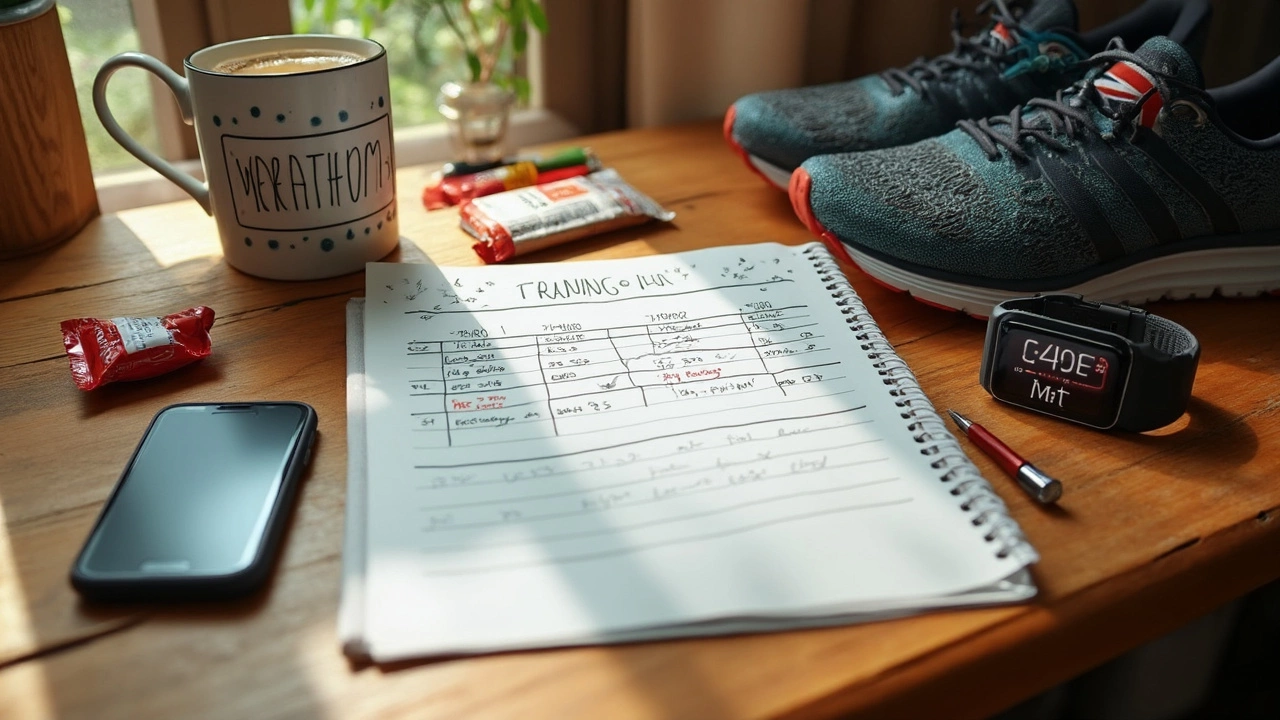Is there a magic number for how far you should run every day? Not really—it's all about your reason for running and where you’re starting from. If you’re training for your first marathon, aiming for what feels 'good' can be pretty confusing, especially once you see pros logging crazy distances online.
The truth is, running the same distance every day isn’t always the best move, even if it sounds simple. You want steady progress, but you also want to keep your knees and motivation in one piece. I’ve seen plenty of rookies go too hard, too soon, only to end up with sore legs or worse, sitting out the big race.
So, what should you be doing instead? Think about your experience, what your week looks like, and how your body feels. There’s a sweet spot where you’re building your endurance, getting stronger, and still able to show up again the next day. Keep reading—you’ll figure out exactly how far you should go, and how to tweak it for real life.
- Why Daily Distance Depends on Your Goal
- How Beginners Should Set Their Mileage
- What Experienced Runners Actually Do
- The Risks of Running Too Much
- Balancing Rest and Hard Work
- Building a Realistic Marathon Routine
Why Daily Distance Depends on Your Goal
Let’s get one thing clear: there isn’t a perfect number of miles or kilometers every runner should log each day. It all boils down to what you’re working toward. Are you chasing a marathon PR, or just hoping to finish your first 42K without feeling like toast? Your answer actually changes what your daily distance should look like.
If your main thing is marathon training, running every day might sound ambitious, but it isn’t for everyone—especially if you’re just getting your feet wet. Beginners running five or six days a week usually go for shorter, easier distances, something like 3–5 miles (5–8 km) per day. More advanced runners mix it up: yes, they’ll have days pushing 7–10 miles (11–16 km) or more, but will balance those with plenty of recovery miles and even complete rest days.
Here’s a quick snapshot of typical weekly and daily mileage for different goals:
| Runner Type | Daily Distance (Typical) | Weekly Total | Goal |
|---|---|---|---|
| Casual Beginner | 2–4 miles | 10–20 miles | Finish marathon |
| Intermediate | 4–8 miles | 25–40 miles | Finish strong/get faster |
| Advanced/Competitive | 6–12 miles | 40–70+ miles | PR, qualify for Boston, etc. |
Your personal daily distance should also fit around your lifestyle. Got a busy job or family stuff? Maybe focus on 3–4 strong runs a week. Training for that sub-4-hour marathon and have plenty of time? Then, you’ll likely need to dedicate longer weekday runs and regular long runs on weekends.
The key is matching your daily distance—and your total weekly mileage—to your specific goal, fitness level, and real life. It’s way better to build up slowly than to try copying someone else’s plan and getting injured or burned out.
How Beginners Should Set Their Mileage
First things first—if you’re a beginner aiming for a marathon, you don’t need to run a marathon distance every day. Not even close. The sweet spot for newer runners is starting with short, easy runs three or four times a week. Think somewhere between 2 to 4 miles each run for the first couple weeks, just to get your legs used to it.
The biggest mistake people make is doing too much, too fast. According to the famous "10% rule," don’t add more than 10% to your total weekly mileage from one week to the next. For example, if you ran a total of 12 miles last week, next week you can bump it up to around 13 or 14 miles. This helps keep you healthy and lowers your risk of injury from going too hard right out of the gate.
It really helps to use a simple plan. Most beginner marathon training plans start at 12 to 16 miles per week and build up gradually over several months. You’ll usually see programs that have a mix of short weekday runs and one longer run on the weekend. Here’s what a basic week for a beginner might look like:
- Monday: Rest or easy cross-training
- Tuesday: 3 miles easy run
- Wednesday: Rest or easy 3 miles
- Thursday: 3 miles easy run
- Friday: Rest
- Saturday: 4 miles long run
- Sunday: Rest
This is just a start—if two or three miles feels like a lot, it’s totally fine to walk parts of it. The main thing is consistency, not speed. You want your body to get used to moving for longer stretches and to avoid burning out.
Stick with the marathon training plan you choose, and listen to your body along the way. Soreness is normal, but sharp pain isn’t, so don’t be afraid to take extra rest if something feels off. Over time, your mileage will go up, and you’ll be surprised at how much you can handle with steady effort.
What Experienced Runners Actually Do
If you peek at the habits of experienced marathon runners, you’ll see there’s no single number they stick to every day. These runners are all about variety, not just clocking the same miles each time they lace up. For marathon training, it’s normal to have hard days, easy runs, long sessions, and plenty of rest sprinkled in.
On average, experienced runners log around 40–60 miles per week when prepping for a marathon. But they don’t just split those miles evenly. Here’s what their week usually looks like:
- Long run: Once a week, most seasoned runners tackle a long run—usually between 15 and 22 miles as they get closer to race day. This builds endurance and teaches the body to handle marathon distance.
- Easy runs: Several runs each week are “easy,” meaning you could hold a conversation while running. These might be 4–8 miles at a relaxed pace, letting legs recover.
- Speed sessions: A lot of plans include one speed workout each week, like intervals or tempo runs. These are shorter days but push your limits for pace.
- Rest or cross-training: Most marathoners take at least one full rest day, or swap in cycling, swimming, or yoga to give joints a break.
Big thing to notice—there’s never one “perfect” marathon training distance per day. Mixing it up is what actually works. These runners pay a ton of attention to how their bodies react. If something feels off, they cut back. That’s huge for staying injury-free and actually making it to the start line healthy.
One handy fact: The world’s best marathoners often train twice a day, but they started with far less. Most regular folks never need to try that. Build a plan where your mileage grows over time, not overnight. Watching how seasoned runners approach different days is a good way to see what helps fitness without burnout.

The Risks of Running Too Much
It sounds tough, but piling on too many miles day after day isn't actually the best move. In marathon training, there's a fine line between building endurance and heading straight for injury alley. Overdoing it leads to a bunch of problems that can mess up your whole plan—and your body.
Let’s get into the facts. Overuse injuries are no joke. The American Academy of Physical Medicine and Rehabilitation says that up to 70% of runners get injured every year, and running too far too often is a huge reason why. You might start with mild soreness, but push it too hard and you could end up with stress fractures, IT band pain, or shin splints that keep you off the road for weeks.
Piling on miles also messes with your immune system. A Swedish study from 2021 tracked marathon trainees and found that runners who didn’t take regular rest days ended up sick about 20% more often than those who did. Getting sick or injured means lost training time and more frustration.
If you’re not convinced, check out these numbers:
| Training Habit | Injury Rate | Lost Training Days (Annually) |
|---|---|---|
| Running 7+ days per week | 65% | 90+ |
| Running 4-5 days per week | 35% | 20-30 |
Think you’re getting ahead by running every day? That table shows you’re actually far more likely to end up watching race day from the sidelines.
Instead, smart marathon training means listening to your body. Here’s what you should do to keep your risk low:
- Mix your distances—don’t run the same long stretch every day. Save the longer runs for the weekend.
- Pick at least one full rest day each week to recover.
- If legs feel unusually sore or tired, consider swapping your run for a walk or rest.
Bottom line: More miles sound cool, but they backfire if you end up burned out or injured. Focus on quality, not just how much you run—your body will thank you at the starting line.
Balancing Rest and Hard Work
Figuring out how much downtime you need is one of the trickiest parts of marathon training. You can’t just go full throttle every day and expect to get faster. That’s a quick way to get burned out or hurt.
The big thing to know: your body actually gets stronger during rest, not while you’re hammering out those miles. When you run hard, you’re making tiny tears in your muscles. It’s while you’re chilling on the couch or going for an easy jog that your body repairs and builds them up even tougher.
Serious runners—think people training for marathons year after year—usually follow something called the hard-easy principle. That means if today is a tough workout or a long run, tomorrow needs to be slower or shorter. One study from the Journal of Sports Sciences showed runners who mixed hard and easy days improved much more than runners who pushed hard all week.
Here’s a simple week that balances work and recovery:
- Monday: Easy 3-5 miles (shake out the legs)
- Tuesday: Hard workout (could be intervals or tempo runs)
- Wednesday: Easy run or cross-training (like cycling or swimming)
- Thursday: Medium effort run
- Friday: Rest or super easy jog
- Saturday: Long run (slow and steady)
- Sunday: Rest or short walk
You don’t need to be running every single day. Most pros take at least one full rest day a week, and some schedules have two. It depends on your fitness, age, and past injuries.
Ever wonder what happens if you skip rest? Check these stats from sports medicine research:
| Training Habit | Injury Rate (%) |
|---|---|
| Hard workout every day (no rest) | Over 50% |
| Alternating hard/easy days | Less than 20% |
Rest isn’t being lazy. It’s how you build up stamina and avoid being sidelined. Bottom line? Listen to your body, and treat recovery like any other part of your marathon plan. Some days you smash the miles; others, your job is to relax and get ready for the next challenge.
Building a Realistic Marathon Routine
Planning a marathon routine that you’ll actually stick to is way more important than following some perfect schedule you found online. Real life throws curveballs, and your training should flex with your work, family, and the unexpected.
The basic idea is to blend different types of runs—easy, long, and sometimes speedwork—so you boost endurance without frying your body. Most plans for beginners start at around 15-25 miles (24-40 km) per week and peak at 35-45 miles (56-72 km) closer to race day, usually spread out over four to six runs each week. Here’s how you can break down a week:
- Long run: The backbone of your week, often on weekends. This should slowly grow, maxing out around 18-20 miles several weeks before race day.
- Easy runs: Shorter, relaxed runs for building mileage without extra stress.
- Rest days: Not optional—skipping these often leads to injury.
- Optional speed or tempo workout: Once you’ve built a base and feel good, you can add these for variety and stamina.
Here’s a simple example table showing how a week might look for someone aiming for a 40-mile week at the peak of training:
| Day | Activity | Mileage |
|---|---|---|
| Monday | Easy run | 5 miles |
| Tuesday | Medium run | 7 miles |
| Wednesday | Rest | 0 |
| Thursday | Speedwork | 6 miles |
| Friday | Easy run | 5 miles |
| Saturday | Rest or cross-train | 0 |
| Sunday | Long run | 17 miles |
Remember, the most important thing for marathon training is consistency, not hero miles. If you miss a day, don’t try to cram it in later—just pick up and keep going. Small injuries will set you back more than a couple skipped miles. For most runners, following the 10% rule (don't increase your weekly mileage by more than 10% from the previous week) keeps things manageable and lowers the risk of overuse problems.
Don’t forget to listen to your body. If you're tired or feeling worn down, it’s smart to swap a run for an extra rest day. Building in cutback weeks—where you drop the mileage every third or fourth week—lets your legs recover and makes training more sustainable. Training shouldn’t feel like survival; if you’re dreading each run, back off a little. The finish line comes from sticking with it, not pushing every single day.








